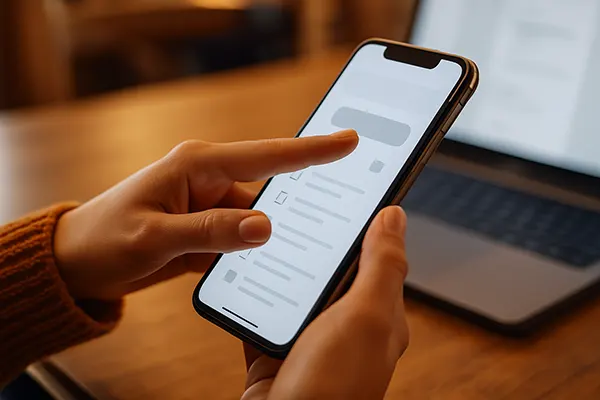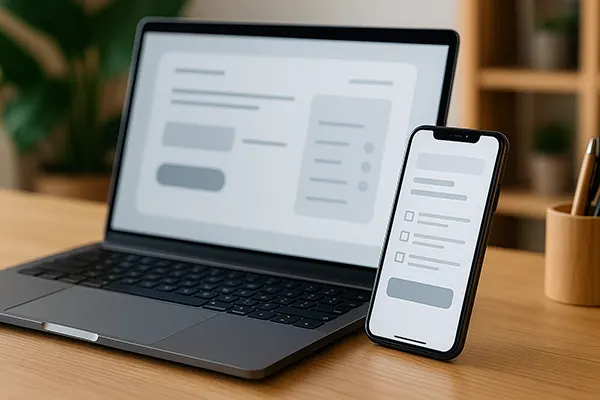
UX Copywriting for Mobile Apps: How to Create Texts That Guide Users
Clear, concise, and context-aware texts are an integral part of a successful mobile experience. UX copywriting is not about slogans or marketing language — it’s about supporting the user’s journey, helping them achieve their goals intuitively and without frustration. In mobile apps, where screen space is limited and attention spans are short, every word matters. This article explains how to write user-focused microcopy that improves navigation, supports interaction, and makes the product feel human.
Understanding the Role of UX Copy in Mobile Interfaces
Mobile UX copy serves a specific function: to guide users without overwhelming them. It replaces guesswork with clarity and reduces the need for external support. In mobile environments, tooltips and lengthy help menus often don’t work — the guidance must be embedded into the interface itself, through labels, buttons, error messages, and instructions.
Effective UX writing is never random. It relies on user research, analytics, and behavioural insights. Copywriters must collaborate with product designers, developers, and QA specialists to test and refine the wording in context. The best microcopy often comes from iterative testing rather than a one-time creative effort.
It’s also important to consider tone of voice. The tone must reflect the brand, but also adapt to the context: friendly on success screens, neutral or empathetic during errors. Poor tone choices in mobile UX can lead to misunderstanding or even user drop-off.
Why Microcopy Improves Usability and Trust
Microcopy — the short instructional or descriptive texts within interfaces — plays a crucial role in building user trust. Button labels, placeholders, loading states, and notifications can either clarify or confuse. A clear “Continue” button paired with a progress indicator gives users confidence. A vague or misleading label, by contrast, may cause hesitation or abandonment.
Effective microcopy uses plain language and avoids jargon. It prioritises user goals, making sure every interaction is self-explanatory. Trust grows when users feel in control and understand what to expect next. For example, replacing “Submit” with “Send Message” improves clarity and lowers cognitive friction.
Consistency in terminology also helps. If an app refers to a feature as “Bookmarks” in one place and “Favourites” elsewhere, the inconsistency creates unnecessary confusion. UX copywriters must work closely with design systems and style guides to ensure linguistic harmony across the product.
Best Practices for Writing UX Texts in Mobile Apps
Start by identifying key moments in the user journey — onboarding, permissions, task completion, errors — where users might hesitate. Then craft messages that answer unspoken questions. For instance, during account creation, users may wonder “Why is my phone number needed?” Anticipating and answering such concerns improves flow and reduces abandonment.
Character limits are a major constraint in mobile UX writing. A helpful rule is to aim for brevity without losing clarity. Replace phrases like “In order to continue” with “To continue”. Avoid redundancy: instead of “Click the button below to start,” use “Start.” Write for scanning, not reading. Most users skim interface text — bold verbs and meaningful keywords stand out.
Testing is essential. A/B tests can measure how wording affects user behaviour, but qualitative feedback is equally valuable. Usability sessions often reveal where users pause, misinterpret or fail to act. Good UX copy addresses these blockers and adapts to real-world use cases.
Voice and Tone: Adapting to User Context
Voice is the personality of your app; tone is how that personality changes in different contexts. UX writers must fine-tune tone according to user emotions. A success message might be cheerful (“You’re in!”), while an error requires empathy (“We couldn’t connect. Try again in a moment.”)
Formality levels should match the user base and the type of app. A banking app might adopt a more serious tone, while a fitness tracker can afford to be playful. But tone should never sacrifice clarity. If a quirky message delays comprehension, it fails the UX test.
Remember, tone also applies to visuals. The copy must align with design. If an interface is minimalistic, the tone should be straightforward. UX copywriting is a collaborative act — it must serve the design, not fight against it.

Creating Inclusive and Accessible UX Texts
Inclusive UX writing ensures that all users, regardless of ability, background, or experience, can understand and interact with the app. This means avoiding idioms, metaphors, and culturally specific references that could exclude or confuse.
Accessibility also includes screen reader compatibility. Labels must be descriptive and correctly paired with their functions. For example, a button should not just say “Click here,” but “Submit order” or “Save settings.” This provides clarity for all users, not just those using assistive technologies.
Language localisation must also be considered early. Text expansion in translation (especially to German or Finnish) can affect UI layout. UX copywriters should collaborate with localisation teams and ensure the original English copy is adaptable and context-aware.
Final Tips for UX Copy Success
Document your UX copy decisions. Keep a writing system or copy style guide that outlines preferred terminology, tone rules, and example patterns. This ensures consistency as the app grows and new writers join the team.
Review microcopy in situ — always test your text inside real interfaces, not in spreadsheets or mockups. Context reveals whether a message feels too long, too vague, or visually unbalanced. Collaborate with designers and front-end developers to iterate and improve.
Above all, write with the user in mind. Good UX copy feels invisible — it helps, explains, reassures, and moves the user forward without being noticed. That’s the highest compliment for any interface writer.
